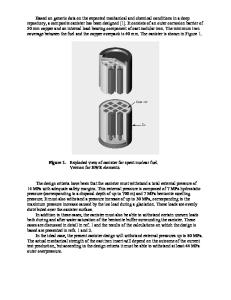Radionuclide Transport Calculations in the Safety Assessment SR 97
- PDF / 632,039 Bytes
- 9 Pages / 612 x 792 pts (letter) Page_size
- 45 Downloads / 299 Views
Radionuclide Transport Calculations in the Safety Assessment SR 97 M. Lindgren1 and F. Lindström2 1 Kemakta Consultants Co., Box 12655, S-112 93 Stockholm (Sweden) 2 Swedish Nuclear Fuel and Waste Management Co. (SKB), Box 5864, S-102 48 Stockholm (Sweden). ABSTRACT This study treats radionuclide transport calculations for a canister defect scenario in the safety assessment SR 97, which concerns a deep repository for spent nuclear fuel of the KBS-3 type in Sweden. The aims of the calculations are to: • Quantitatively describe the radionuclide transport. • Show the impact of uncertainty in input data and show which parameters govern the
calculated release rates. • Compare three different real sites in Sweden (Aberg, Beberg and Ceberg) with each other
and with dose limits given in Swedish regulations (none of the sites is considered in the on-going localization process). Only briefly described in this paper. • Illustrate the impact of the different barriers in the system. Deterministic calculations illustrate the radionuclide transport for reasonable conditions. Uncertainty cases show the influence of the uncertainty for data related to different parts of the repository system by systematically giving them pessimistic values while all others are reasonable. Simplified probabilistic calculations have also been performed. The analysis shows that the most important parameters in the near field are the number of defective canisters and the instant release fraction. In the far field the most important uncertainties affecting release and retention are connected to permeability and connectivity of the fractures in the rock. The dose rate in the biosphere is essentially controlled by the possibilities of dilution. The calculated maximum doses for the hypothetical repositories are well below the dose limits, and hence they meet the acceptance criteria for a deep repository for spent fuel. INTRODUCTION The Swedish Nuclear Fuel and Waste Management Company, SKB, has developed a disposal method known as the KBS-3 concept. The concept involves final disposal of spent nuclear fuel in sealed copper canisters with high strength cast iron inserts, emplacement of the canisters surrounded by bentonite clay in boreholes drilled into the floor of disposal galleries, and the location of these galleries at a depth of about 500 m in Swedish crystalline bedrock. This study treats radionuclide transport calculations for a canister defect scenario, which forms part of the safety assessment SR 97 [1] for this deep repository concept. A more thorough report of the calculations is given in [2].
CALCULATIONS A schematic view of the near field assumed for the canister defect scenario is given in Figure 1. The nuclides may escape from the canister through a small hole into the bentonite by diffusion. The transport continues to one of the four possible exit paths, indicated in the figure as Q1-Q4.
Figure 1. Schematic view of the near field, showing a small hole in the canister and the location of various transport paths into the near-field rock.
Data Loading...











